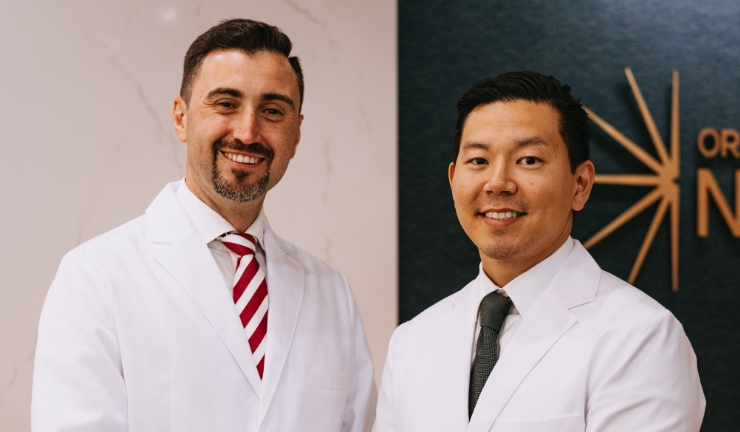A bone graft augmentation is designed to reconstruct the horizontal or vertical aspect of the jawbone. The complexity of these grafts varies, which is why it is important to follow the individual recommendations provided by the doctor. The grafts can be disturbed easily by touching the surface of the graft or chewing on the surgical site. This surface disruption could cause the graft to fail. You can prevent problems during the healing time by avoiding any contact or eating on the graft area. It should remain undisturbed for the entire healing period.
The grafts are an opportune area for bacteria to grow, which means they can become infected easily. Taking your prescribed antibiotics and following the provided hygiene instructions will reduce the likelihood of infection.
If you notice a “bump” on the inside or outside surface where the graft was placed, don’t be alarmed. It is normal and doesn’t necessarily indicate the presence of an infection. Leave the bump alone – do not feel the bump or play with it with your tongue. Be careful to avoid sleeping on this area because the weight and pressure could disturb the graft.
Early Care After Surgery
On the day of the surgery, patients have optimal results when following this sequence:
- Control Bleeding First: The patient should stay in a sitting position and bite on gauze until the bleeding stops. Do not spit. Apply ice packs to the affected areas immediately.
- Eat Something: Getting something in the stomach is important. A milkshake is suggested.
- Start Medications: If the patient is experiencing pain, then the pain medication should be taken first, followed by the antibiotic an hour later. If the patient is not experiencing pain, then the antibiotic should be taken first, with the use of pain medication when the pain is starting to occur.
Bleeding
It is important that you follow the specific directions provided in the office to control bleeding. Most patients don’t have much bleeding after this surgery, but it is common to experience swelling. If you don’t see blood coming out of the gum, then it is ideal to not use pressure gauzes since they can disturb the graft.
Ignore bloodstain on the gauze as a sign of bleeding. Ideally, someone other than the patient should check for bleeding. Look at the wound directly for 20–30 seconds, using a flashlight and spoon handle (as a retractor) if needed. Don’t be surprised if the patient can’t open wide. A partial opening should be sufficient for you to see if it is bleeding.
Only apply a gauze if you see blood coming directly from the wound, and only using the techniques as shown in the office. If you are uncertain about the bleeding, then it is recommended to leave the wound alone for an hour and then check it again. After an hour, if there is no change in the amount of blood in the area, then the gauze should be left out.
Variable bleeding is expected after oral surgery. It is not uncommon to experience oozing, slight bleeding, or redness in the saliva. If the bleeding doesn’t subside, then please call our office.
Sleep with the head elevated and do not lay on the graft side. Consider placing a towel to cover your pillow the night of the surgery. Minor oozing and drooling might occur while sleeping.
Pain
The first 12–24 hours are usually when the most discomfort is experienced. Severe pain can be treated using the prescribed medications, taken as directed. Moderate pain can be treated using ibuprofen (Advil or Motrin: 200mg tablets, taken every 3–4 hours). Tylenol can be used as well, following the dosage recommendations as listed on the package.
Keep in mind that most pain medications can cause an upset stomach. The risk of stomach discomfort is highest when medication is taken on an empty stomach and prescription pain medication is used. If general anesthesia was used and the stomach is empty, then it is recommended to drink a milkshake followed by the first dose of medication 30 minutes later. A more effective option is to eat something soft and bulky (mashed potatoes, oatmeal, ground meat, etc.) 30 minutes before the medication.
Important Medication Reminders
CAUTION: Patients should not drive or operate mechanical equipment when using prescription pain medication. Also, alcohol should not be mixed with any type of pain medication (over-the-counter or prescription). Do not mix alcohol with antibiotics.
- Different medications should be spaced at least an hour apart from each other
- Eat food with some thickness 30 minutes before taking medication
- Always follow the dosage and frequency prescribed on each bottle
- Pain medications are beneficial to take the edge off of strong pain, but they do not eliminate all pain
- Avoid alcohol when using pain medication and/or antibiotics
- If taking narcotic medications, you should not work or drive a vehicle
Postoperative pain varies between patients. The worst pain is usually experienced in the first 72 hours, but some people experience a worsening of pain after the first few days. The overall trend is that pain should taper off within 5–6 days, although it is common to experience pain variations from one day to the next.
Exercise, strenuous activities, or following a “busy” lifestyle tends to cause a throbbing sensation in the wound. Use common sense and minimize activities if you find the pain or discomfort intensifies.
Antibiotics
If you have been prescribed antibiotics, then the first dosage should be taken 1 hour after taking pain medication. Continue using this medication as prescribed until the entire prescription has been finished.
Be aware that antibiotics might decrease the effectiveness of other medications, such as birth control pills. Talk to your obstetrician to know how long alternative birth control methods should be used after stopping the antibiotic.
Swelling
Drs. Blecha and Jandali use precise surgical techniques to minimize and prevent swelling whenever possible. But the swelling that occurs will be proportional to the procedure. It is common for patients to experience swelling around the cheeks, mouth, eyes, and sides of the face. This reaction is expected and a normal part of the healing process. Usually, the swelling peaks within 72 hours, then will take 5–6 days to subside.
Ice packs can be used for swelling reduction. If you don’t have ice packs, homemade packs can be created using a Ziploc bag filled with ice. All ice packs should be wrapped in a dry washcloth or hand towel before applying the pack on the sides of the face.
Ice can be used in 30-minute intervals: 30 minutes on, 30 minutes off. Start the ice pack treatment on the day of the surgery and continue as needed – up to 72 hours after the surgery. After 72 hours, you can bring the swelling down by placing moist, warm, heat applications on the sides of the face.
Smoking
It is recommended that patients shouldn’t smoke for the first 48 hours after surgery. Preferably, patients should wait for a week after surgery before smoking again.
Diet
Reestablishing your diet after oral surgery is beneficial to promote healing. Chewing might be difficult in the first 5–6 days if your jaw is stiff and difficult to open.
When the bleeding stops, we recommend a milkshake. Next, patients can move on to soft, bulky foods, such as oatmeal, mashed potatoes, and ground meat. These ingredients are important in preventing vomiting and nausea from the use of medications.
Ask a family member to chop up the foods into small enough pieces so you can eat them with a spoon and swallow without chewing. Drink 5–6 glasses of liquid per day to supplement the bulky foods.
Even if your jaw is stiff and sore, you must be consistent with eating bulky foods so your stomach can tolerate your medications.
Nausea and Vomiting
The risk of postoperative nausea and vomiting is highest when the patient isn’t eating well and is taking postoperative medications. Pain medications are commonly the cause of stomach upset.
If nausea and/or vomiting is experienced after the surgery, then don’t eat or take anything by mouth for an hour (including prescribed medications). Slowly sip on a Sprite or Coke for 15 minutes.
When the nausea subsides, try to eat bulky foods (as listed above). If these foods are tolerated, then you can try to resume the use of medications once again. Usually, the narcotic pain medication is the cause of nausea. If these prescriptions are needed for pain management, be slow in resuming the use of the prescription and try taking a lower dose to minimize nausea.
Oral Hygiene
Do not rinse or brush your teeth for 24 hours after surgery. After 24 hours, clean the mouth by brushing and following the salt-water rinses as directed below. Keep in mind that good hygiene after surgery is essential to help your mouth heal faster and to reduce the pain as quickly as possible. If you are too “shy” to brush and rinse, then it increases the likelihood of the development of a postoperative wound infection and pain that worsens.
Twenty-four hours after tooth extraction, all of the teeth should be brushed (including the teeth adjacent to the surgical site). Don’t scrub too hard. Instead, carefully clean the surface of all teeth, including “nooks and crannies” where food can get stuck.
At this time, you should also start using salt-water rinses. Mix 1/2 teaspoon salt in a glass of warm water, then gently “swish” to remove food that gets stuck in the surgical wounds. You should brush and rinse – saltwater swishing does not replace brushing.
If you find it difficult to open your stiff jaw 4–5 days after surgery, then stretching exercises can be used so you can open your mouth wider. Not only will opening your mouth wider make it easier to clean your teeth, but it also improves your ability to eat.
REMEMBER: A clean wound heals better and faster.
Activity
Immediately following surgery, physical activities should be kept to a minimum. Avoid exercise for 5–6 days. Strenuous activities can result in throbbing or bleeding. If these problems occur, then you should discontinue the activity.
During this recovery time, your normal caloric intake may be reduced because it is difficult to eat. As a result, exercise may weaken you. If you are feeling light-headed, then stop exercising. Be careful to ease your way back into an exercise routine to avoid complications for your recovery.
Discoloration
Some patients experience skin discoloration after surgery. When the blood spreads beneath the tissues, it can cause the development of green, blue, black, or yellow discoloration. This postoperative discoloration is normal, and usually shows up 2 or 3 days after surgery. Moist heat can be applied to the area to speed up the healing and fade the discoloration.
Sore Throat & Corners of the Mouth
The IV anesthesia or extractions can cause the development of a sore throat. The throat muscles are near the surgical site, and it can cause pain when these muscles swell. This pain is normal and should subside in 2–3 days. Saltwater gargling can help to reduce the pain.
During the surgery, the corners of the mouth can be stretched – causing them to crack and dry out. This discomfort can be managed by applying lip balm or an ointment (such as Vaseline) to keep the corners of the mouth moist.
Wearing Your Prosthesis or Night Guard
Immediately after the surgery, temporary teeth (partial dentures, flippers, or full dentures) should not be worn. Unless you have received specific instructions, wait until you’ve had a conversation with the doctor at your postoperative appointment. Contact our office if you have questions about your individual situation.
If you use a prosthesis or night guard, it should not touch the gum area affected by the surgery. If this contact occurs, it can result in ulceration of the wound edges, which can break down the suture margins – and ultimately lead to the loss of the graft. Use caution and talk to the doctor if you have any concerns about the fit of the prosthesis or night guard.
Post-Operative Complications
If you suspect that you are having a problem after your surgery, please call the office to schedule a follow-up appointment with Drs. Blecha and Jandali.
We are Here to Help
Our goal is that your recovery will be as pleasant and smooth as possible. This information is provided to assist you in caring for your wounds. If you have questions about the instructions or your progress, then you are welcome to call us any time.



